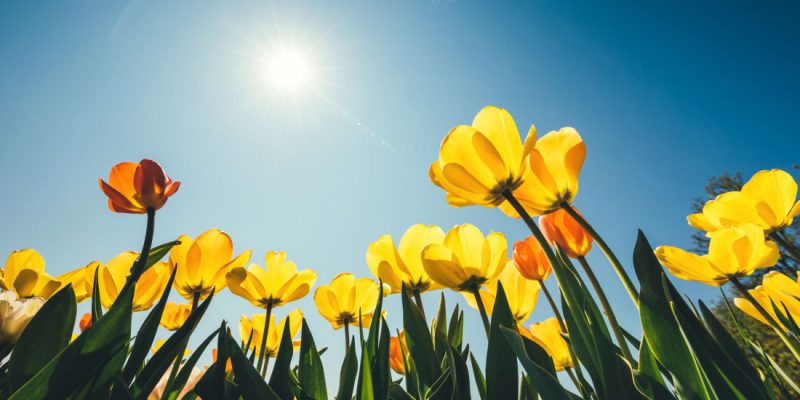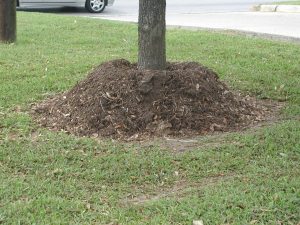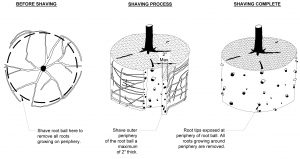
We’re all heading out into the garden right about now, so it might be useful to pay attention to what not to do.
The information on root correction in this article generally applies to all container-grown plants, trees, shrubs and perennials and might help your garden thrive.
The dreaded mulch volcano …
A very common mistake people make after planting a landscape tree is over-mulching—specifically, mulch piled against a tree’s base, as shown on the right. Just google “Mulch Volcano” and you’ll see plenty of examples. Arborists warn against this all the time, but for some reason the practice persists. Perhaps the world doesn’t get it because the damage doesn’t show up immediately—in fact the damage usually takes years to set in and by then the mulch volcano may have already killed the tree.

Piling mulch up around a tree’s trunk can damage a tree in two ways. First, the moisture beneath the mulch is conducive to rot. Once the bark begins to rot, it can no longer provide a natural barrier against invasion by insects and pathogens. Second, the shallow feeder roots will grow up to be near the surface of the ground and over time, as the tree trunk gets bigger and expands in girth, these roots will begin to girdle or strangle the tree.
It’s ok to spread a thin layer of mulch under the base of a tree for moisture retention or weed suppression. Just keep the mulch off the trunk, and make sure the root flare is exposed.
Show me the roots please …
What we see above the ground—plant form, structure, branching, trunk, bark, leaves—tells a great deal about the health of a tree. But we still need to know about the below-ground parts, the parts we can’t see. Otherwise healthy-looking plants can be root-bound—a big problem if left uncorrected.
Root-bound plants, like the one shown on the next page, proliferate in even the best nurseries because growers often give plants a nutrient boost before sending them to market. Therefore, it is advisable to pull the plant out of the pot before buying it in order to inspect the roots. (Oh by the way, you should tell the nursery what you’re doing, and why, so they won’t think you’re some kind of plant abuser.) If a tree, or any plant, is root bound, you could opt not to buy it, but it’s relatively easy to correct the root-bound  condition at planting time.
condition at planting time.
After removing the container to expose the roots, one solution is to slice the root ball vertically in a few places with a pruning saw in order to cut through the excessive roots. The plant will grow new roots not confined by the container. Another solution is to tease apart all the roots, knocking off most of the planting medium. The idea is to free up and redirect roots which were curving upwards. However, the best solution, according to the Urban Tree Foundation, among others, is to shave off the outer surface of the root ball—no more than two inches deep—cutting away the bound up roots.
The roots will suffer some damage in the short term, but they’ll quickly recover and grow new root hairs, feeder roots and structural roots. The tree can then grow without the imminent threat of strangulation by roots.
Even though you can’t see them, the roots are a very important half of the tree. So do inspect the roots before buying a tree. And after planting a tree, do not make a mulch volcano!
For further information on tree planting and care see Ed Gilman’s site at the University of Florida, (www.hort.ifas.ufl.edu/woody), and the Urban Tree Foundation, (www.urbantree.org).
